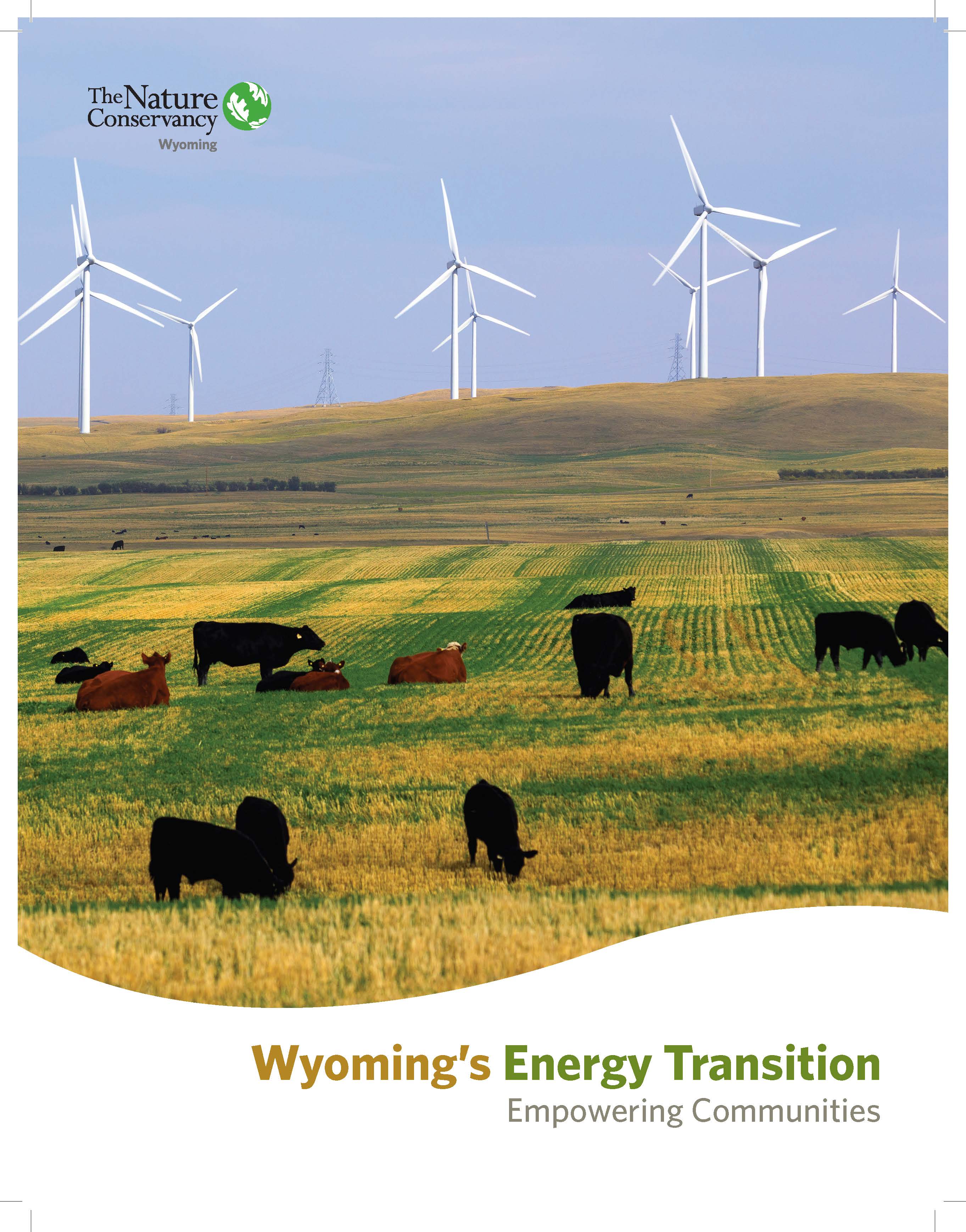Wyoming’s Energy Transition
How to accelerate clean energy in Wyoming while supporting local communities and protecting nature.
Energy communities in Wyoming have powered America’s economic prosperity for decades. They are also embedded in some of the most intact and important temperate ecosystems left on Earth. As the world shifts toward renewable energy to reduce carbon emissions and minimize the effects of climate change, we must also protect wildlife and habitat from poorly sited renewable energy development.
In addition, we must maintain the mutually beneficial social contract that has been forged between the nation’s population centers and its energy communities. Workers in Wyoming’s energy communities have provided a great service to their country. We should not turn our backs on these communities in their time of need. Communities that lose their bedrock industries face a bleak future—one in which young people must leave to find jobs, crime rates increase, roads break down and once-vibrant schools and community services begin to fray. Even the most resourceful rural communities face challenges generating new jobs and prosperity in these conditions.
That’s why prioritizing these communities for re-investment is important. It will help communities maintain their way of life and allow us all to achieve a prosperous future of clean and abundant energy. Repurposing sites of previous energy development like coal mines, power plants, and gas fields represents one of the best opportunities to build new solar and wind energy while avoiding intact wildlife habitat. This is especially important in Wyoming, where big game animals still migrate hundreds of miles across mountains and prairie.
Today, at the cusp of Wyoming’s energy transformation, we have a real opportunity to reinvigorate energy communities with jobs and hope while ensuring that Wyoming’s extraordinary natural heritage will endure for future generations of Wyomingites.
Downloadable Brochure
-
 Wyoming’s Energy Transition: Empowering Communities
Wyoming’s Energy Transition: Empowering CommunitiesTNC outlines the transition of Wyoming’s coal communities to renewable energy to ensure economic stability and protect natural habitats.
DOWNLOAD
Gillette’s Potential as a Clean Energy Powerhouse
Gillette is one of the most important energy communities in America. It boasts a robust oil and gas industry and has been the nation’s leading supplier of coal since the early 1990s. The city is located in the industrial heartland of Wyoming, and the tax revenue generated here funds public services throughout the state. But today, coal production has dropped more than 40% since its peak in 2008. And that decline is accelerating.
The industries in Gillette provide energy products for customers across the world, and those customers arenow demanding zero-carbon products. Fortunately, Gillette has the natural resources to pivot to several clean energy industries.
- Solar and Wind: The region has a high-quality wind resource, an above-average solar resource, and abundant open lands that are low-impact to wildlife and ready for industrial repurposing.
- Carbon Removal: Local geology consists of sedimentary basins that are perfect for permanent carbon storage. Workers in the oil and gas industries already have the workforce skills for carbon removal jobs.
- Dispatchable Clean Power: These technologies are less reliant on local natural resources and depend more on workforce and infrastructure for site selection. But Gillette’s citizens are hard at work innovating in the renewable natural gas, nuclear, and carbon capture and use sectors. High-quality industrial infrastructure at retiring mine sites makes these sites attractive to new manufacturing or energy generation businesses.
The Role of Renewables
Wind and solar businesses generate tax revenue and create jobs in the communities in which they are located. But they are unlikely to replace the taxes and jobs lost during the decline of the fossil fuel industry. Fortunately, due to their low cost and their lack of carbon emissions, these technologies are in high demand for additional economic development in the manufacturing, carbon removal, and data center sectors, among others. By investing in renewable energy, Gillette will be creating the conditions to attract projects that provide much greater tax revenue and higher numbers of good jobs.
Challenges to Deployment
The clusters of coal mines to the north and south of Gillette are the focus for transformative redevelopment in the region. They are areas with low impact on wildlife and valuable transportation and utility infrastructure. Many of them are also retiring from their current purpose. But these sites also have disadvantages.
Reclaimed mines are regulated under the Surface Mining Reclamation and Control Act and have financial liability obligations that last well after closure. The unstable soils of former mining sites also present a construction challenge for new developments of all types, including renewable energy.
Lastly, the most significant challenge may be finding an entity capable of making a significant financial leap that will jumpstart the clean energy economy in the region. Who will make the first important investment? Will renewable energy developers invest in projects withoutm a guarantee of access to new markets? Will a utility company invest in transmission to allow energy to reach those markets before any independent power developers commit resources to a project in the area? Will a manufacturing, carbon removal or computing company commit to building an energy-intensive project in a region that currently can’t supply them with clean electricity? We need to lower the risk for all these parties and help the community transition to a new economic model.
A Roadmap to Accelerating Clean Energy
Here’s what we need most urgently to accelerate deployment of clean energy technologies in the Gillette area:
Funding for up to three mid-size (5–30 megawatt) renewable energy facilities on mine lands. The projects would demonstrate the viability of the concept and help iron out challenges. These medium-sized facilities would be easier for local utilities to fold into their energy grid than a utility-scale facility, and their more modest cost would help ameliorate uncertainties. They would also make zero-carbon energy available locally for other industries, albeit at a limited scale.
A study of transmission bottlenecks for moving electricity from the Powder River Basin to major demand centers. If one or more options is identified as viable, a National Interest Energy Transmission Corridor designation, a low-interest Loan Program Office loan, or another funding mechanism could be pursued in partnership with utility companies. Top priorities would include the Colstrip Region and major Southwest Power Pool markets.
A study of potential upgrades needed to the local distribution system. Interconnection for up to 300 megawatts is available at the Dry Fork substation, and economic developers are working to attract projects to sites in the southern cluster. The information from an upgrades study would allow pre-planning and help reduce risk for projects that want to purchase carbon-free electricity.
A study of geotechnical issues associated with redeveloping post-mining sites in the Powder River Basin. This study would characterize the typical movementexpected on reclaimed sites 5, 10 and 20 years after reclamation. Having these data up front will allow developers to plan and budget more effectively, making projects more likely to succeed and removing uncertainty and risk from potential projects.
Additional help attracting specific industries. Carbon removal, data centers, carbon manufacturing or other industries with specific advantages in the region and large power loads are needed to kickstart Gillette’s transition. A single major project would have a huge impact on this community.
A study of the impact of day-ahead electricity markets on the regional economy. Electricity markets in the West are changing drastically and will be entering unknown terrain. Will these changes lead to new opportunities for which local officials should plan, or will there be new challenges that need to be addressed as soon as possible?
Your support is essential to empowering Gillette and other Wyoming communities as our nation transitions to renewable energy.
To learn how you can set Wyoming up for a strong energy future, please contact:
Justin Loyka, Wyoming Energy Program Director
Justin.loyka@tnc.org or 307-438-9475
Stay connected for the latest news from nature.
Sign up to receive monthly conservation news and updates from Wyoming.







